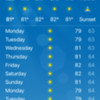No perceptible humidity and 80 degrees today. Can someone explain what a dew-point is? Of course we have no water to drink, but the weather is great!
-=theron
As I understand it, the dew point is the temperature at which water must condense out of the air. Air can hold less and less water as the temperature falls. The temperature cannot fall below the dew point, which often defines the overnight low. That’s why it can get quite cold at night in a desert, even after a triple digit daytime high. This time of year our overnight lows are usually in the low 80s here in Charleston, meaning dew points in the 80s. I know that was a poor explanation, but hopefully it helps.
Close.
The temperature can drop below the dew point (clearly, or winter would be pretty wonderful here). But if it does, the moisture in the air will condense and drop out either as dew or fog or both.
Warm air has the capacity of holding more water, if the water is available to hold. The dew-point is the temperature that the air needs to drop before you reach "saturation" - when the temperature drops to the point where the water suspended in the air starts precipitating (dropping out of suspension). The more water suspended in the air, the higher that point will be. If the dew-point in Charleston is 80° (and I've seen it for myself), that air is really heavy with water - "air you can wear". If the dew-point in Phoenix is 50°, there's not a lot of water in suspension.
Water in the air is a huge heatsink and moderates the temperature. There are other factors at play, but on the surface of the moon (a 0% humidity environment), the temperature gets to 260° on the side facing the sun, and -297° on the dark side. The lack of moisture hanging in the air is why deserts are blazing hot in the day, and pretty magical at night.
With all the water in the air in places like Charleston and Peoria (to a lesser extent), once the air temperature reaches dew-point, the heat transfer goes from sensible (what you can measure on a dry-bulb thermometer) to latent (which is measured with a wet-bulb psychrometer). Latent heat is the heat energy is being used to condense the moisture before the dry-bulb thermometer drops any further. As Lane got (almost) right, if there's a lot of moisture in the air, the sensible temperature will often not drop past the dew-point. With less water in the air, it can punch through... once the condensable water has already dropped out of suspension (again, the desert night).
There is an enormous amount of heat energy absorbed with the evaporation and condensation process - an enormous amount of heat energy is used to turn 211° water into 213° steam (much more than to raise the temperature of water 2°, and much, much more than the heat energy to raise the temperature of steam the same amount). It works in reverse too - there's an enormous amount of heat energy used to take humidity suspended in the air and drop it out in the form of dew.
Swamp coolers work in low humidity environments because the heat energy absorbed by evaporating the water in the cooler actually cools the space. Your body does the same thing by sweating. This is why swamp coolers only work in the desert, and why sweat rolls off your nose in the deep-south. When you sweat in Barstow, your perspiration evaporates almost immediately and cools you to some degree (which is good, because the sensible temperature is over 100°. When you sweat in Charleston, the air is already near its carrying capacity for water - so rather than evaporating (and cooling you), your sweat just pools and rolls off. It's kinda' gross feeling.
Dew-point is used to calculate RH (relative humidity), which is a calculation based on the sensible temperature and the dew-point and expressing it as a percentage. Think of RH as a "gas gauge" for water in the air - it measures the percentage of water in the air as compared to the capacity of the air to hold water at a certain sensible temperature. The humidity is never "100%" unless it's pea-soup fog or raining, and the RH is always higher in the early morning, because the air temperature (and therefore, it's capacity to hold water) has dropped, but the water that was in the air is still there (until the temperature reaches dew-point and drops out of suspension). It feels worse in the afternoon, but the RH is actually lower (because the sensible temperature is higher)
It's kinda' cool (in a geeky sort of way) when you stop and think about why things work the way they do.




